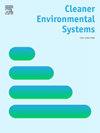Environmental assessment of organic dairy farms in the US: Mideast, northeast, southeast, and mountain regions
IF 4.9
Q2 ENGINEERING, ENVIRONMENTAL
引用次数: 0
Abstract
Greenhouse gas (GHG) emissions, ammonia (NH3) emissions, eutrophication potential (EP), use of fossil energy, direct land, and blue water of organic dairy farms are evaluated in the Mideast, Northeast, Southeast, and Mountain regions of the US. Eighteen archetypical organic dairy farms are modeled with GHGs per kg fat and protein corrected milk (FPCM) ranging between 0.83 and 1.45 kg CO2-eq with and 0.93 to 1.59 kg CO2-eq without carbon sequestration. Enteric methane (CH4) is the major contributor (42–58%) of farm GHGs, followed by CH4 from manure (15–27%), energy use (8–18%), and material inputs (3–24%). Enteric CH4 is affected by feed efficiency and milk production, manure CH4 by the type of manure handled and stored, and GHGs from energy by the content of fossil-fuel sources in the electricity grid mix. Manure is the major source of NH3 emissions ranging from 8.2 to 24.3 g/kg FPCM. Alternative GHG mitigation strategies show potential reductions of up to 23 and 51% for individual and combined strategies, respectively. While enteric CH4 is the greatest GHG contributor, manure management has greater GHG mitigation potential. The choice of CH4 predictive equations, N2O emission factors, allocation, and functional units could increase GHGs up to 43% in the evaluated organic dairy farms.

美国有机奶牛场的环境评估:中东、东北部、东南部和山区
对美国中东、东北部、东南部和山区有机奶牛场的温室气体(GHG)排放、氨(NH3)排放、富营养化潜力(EP)、化石能源利用、直接用地和蓝水进行了评价。18个典型的有机奶牛场以每公斤脂肪和蛋白质校正奶(FPCM)的温室气体排放量为模型,其范围在0.83至1.45千克二氧化碳当量之间,在没有碳固存的情况下为0.93至1.59千克二氧化碳当量。肠道甲烷(CH4)是农场温室气体的主要来源(42-58%),其次是粪便(15-27%)、能源使用(8-18%)和物质投入(3-24%)。肠道CH4受饲料效率和牛奶产量的影响,粪便CH4受处理和储存的粪便类型的影响,来自能源的温室气体受电网混合中化石燃料来源含量的影响。粪便是NH3排放的主要来源,排放范围为8.2至24.3 g/kg FPCM。替代的温室气体缓解战略表明,单独战略和联合战略的潜在减量分别高达23%和51%。虽然肠道CH4是最大的温室气体贡献者,但粪便管理具有更大的温室气体缓解潜力。CH4预测方程、N2O排放因子、配置和功能单元的选择可使有机奶牛场的温室气体排放量增加43%。
本文章由计算机程序翻译,如有差异,请以英文原文为准。
求助全文
约1分钟内获得全文
求助全文
来源期刊

Cleaner Environmental Systems
Environmental Science-Environmental Science (miscellaneous)
CiteScore
7.80
自引率
0.00%
发文量
32
审稿时长
52 days
 求助内容:
求助内容: 应助结果提醒方式:
应助结果提醒方式:


